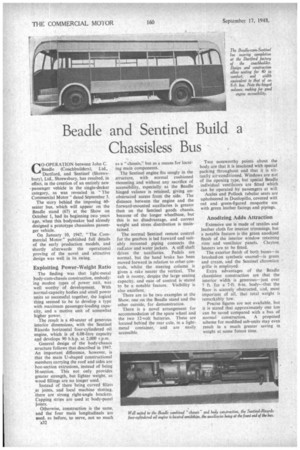Beadle and Sentinel Build a Chassisless Bus ,
Page 34

If you've noticed an error in this article please click here to report it so we can fix it.
C0-OPERATION between John C. Beadle (Coachbuilders), Ltd., Dartford, and Sentinel(Shrewsbury), Ltd., Shrewsbury, has resulted, in effect, in the creation of an entirely new passenger vehicle in the single-decker category, as was revealed in "The Commercial Motor" dated September 3.
The story behind the imposing 40seater bus, which will appear on the Beadle stand (67) at the Show on October 1, had its beginning two years ago, when this bodymaker had already designed a prototype chassisless passenger vehicle.
On January 10, 1947, "The Commercial Motor" published full details of the early production models, and shortly afterwards the operational proving of the novel and attractive design was well in its swing.
Exploiting Power-Weight Ratio
The finding was that light-metal body-cum-chassis construction, embodying modest types of power unit, was well worthy of development. With normal-capacity bodies and small power units so successful together, the logical thing seemed to be to develop a type with maximum passenger-loading capacity, and a motive unit of somewhat higher power.
The result is a 40-seater of generous interior dimensions, with the Sentinel Ricardo horizontal four-cylindered oil engine, which is of 6.08-litre capacity and develops 90 b.h.p. at 2,000 r.p.m.
General design of the body-chassis structure follows that described in 1947. An important difference, however, is that the main U-shaped constructional members carrying the roof and sides are box-section extrusions, instead of being H-section. This not only provides greater strength, but lighter weight. as wood fillings are no longer used. • Instead of there being curved fillets at joints, and local machine slotting. there are strong right-angle brackets. Capping strips are used at body-panel joints.
Otherwise, construction is the same. and the four main longitudinals are used, as before, to serve, not so much
;s32 as a "chassis." but as a means for locating main components.
The Sentinel engine fits snugly in the structure, with normal cushioned mounting and without any sacrifice of accessibility, especially as the Beadle hinged valance is retained, giving unobstructed access from the side. The distance between the engine and the forward-mounted auxiliaries is greater than on the Sentinel goods chassis, because of the longer wheelbase, but this is no disadvantage, and correct weight and stress distribution is maintained.
The normal Sentinel remote control for the gearbox is led forward and suitably mounted piping connects the rad:ator and water jackets. A stiff shaft drives the auxiliaries. Pedals are normal, but the hand brake has been moved forward in relation to other controls, whilst the steering column is given a rake nearer the vertical. The cab is roomy, despite the large seating capacity, and ease of control is stated to be a notable feature. Visibility is also excellent.
There are to be two examples at the Show, one on the Beadle stand and the other outside, for demonstration.
There is a novel arrangement for accommodation of the spare wheel and the two 12-volt batteries. These are located behind the rear axle, in a lightmetal container, and are easily accessible. Two noteworthy points about the body are that it is insulated with special packing throughout and that it is virtually air-conditioned. Windows are not of 'the opening type, but special Beadle individual ventilators are fitted which can be operated by passengers at will
Accles and Pollock tubular seats are upholstered in Dunlopillo, covered with red and green-figured moquette anc with green leather facings and pipings.
Anodizing Adds Attraction
Extensive use is made of textiles and leather cloth for interior trimmings, but a notable feature is the green anodized finish of the interior window retaining rims' and ventilator panels. Clayton. heaters are to be fitted.
The exterior finish of both buses—in brushed-on synthetic enamel—is green and cream, and the Sentinel chromiurr grille is employed.
Extra advantages of the Beadle chassisless construction are that the interior width is generous—just over 7 ft. for a 7-ft. 6-in, body—that the floor is scarcely obstructed, and, most important of all, that total weight is remarkably low.
Precise figures are not available, but it is stated that approximately one ton can be saved compared with a bus of normal construction. A proposed scheme for modified sub-units may even result in a much greater saving in weight at some future time.




















































































